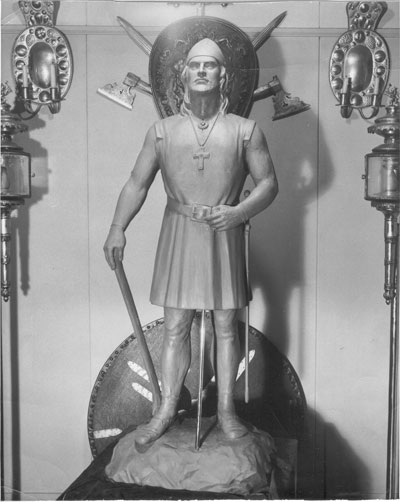
The Saga of Seattle’s Leif Erikson Statue
By Kristine Leander
©2005
“The old saying is true…It is easier to be wise after the event.” Eirik the Red, Saga of Eirik the Red.
Was Eirik the Red simply telling us that hindsight is 20-20? Or did he mean something deeper—that it’s easier to know the truth of an event afterward? If so, was he right? Nearly 45 years after the creation of the Leif Erikson statue at Seattle’s Shilshole Marina, determining the truth of the project calls for detective work and an understanding of human nature.
But first, why a statue of this particular Viking in Seattle? Icelandic-born Leif Erikson, who according to the sagas was the first European in America, has particular resonance for Scandinavian Americans. Even though his father, Erik the Red, was born in Norway, Leif is not particularly well known in Scandinavia. Across America, however, Leif is a symbol of Nordic immigration, a trailblazer and hero. His voyage to America in 1000 put him ahead of Christopher Columbus, and during the height of immigration in the late 19th century, gave clout to Scandinavian Americans. At a time when European immigrants were rubbing shoulders and bumping elbows on the streets of America, Scandinavians could claim that they landed even before the Italian Christopher Columbus or the English-speaking Pilgrims. It is significant that the first statue of the famous Nordic adventurer was erected in 1887 in Boston, known not for its Scandinavian immigration, but instead for Italian and Irish immigrant populations and nearby Plymouth Rock, where the Pilgrims landed.
Seattle’s statue of Leif Erikson was a gift from the Leif Erikson League for the 1962 World’s Fair. Trygve “Ted” Nakkerud—one of the longest-living members of the group responsible for the statue—was the force behind the statue’s fundraising and creation, and he loved telling its history. If the sculptor August Werner was its father, Trygve was its mother. I met him in 1994, when he was 92, and more than once heard the following tale.
He reported that the Leif Erikson League—by his description a Norwegian social club accustomed to celebrating October 9 as Leif Erikson Day, drinking heartily on the 17th of May, marching in parades, and sailing on Lake Washington—made a motion in 1956 to raise funds for a statue. They held a contest at the old Norway Hall, now the Mountaineers building, to select a sculptor to design a statue of Leif Erikson as a gift to the city of Seattle. Trygve, a farmhand, logger, fisherman, and union leader, would lead the Leif Erikson League in raising the funds. Even though he did not submit a design, Professor August Werner—a multitalented singer, artist, sculptor, instructor at the University of Washington, and director of the Norwegian Male Chorus—was allowed to become the sculptor simply due to his sway within the community. According to Trygve, “No one says no to August Werner.”
August and Trygve enlisted the aid of another member of the Norwegian-American community, architect John Engan. Guided by a Norwegian history book, the three men first created a 4-foot model in August’s dining room—furniture removed except for a piano. (A widower, August didn’t mind the project displacing his dining room table.) They worked until two or three o’clock in the morning for days. August entertained them with songs, “fresh cooked coffee” and pastries.
Shortly after they completed it, according to Trygve’s telling, August invited a Seattle Times reporter for a viewing, but removed the supports supplied by John, the architect, who was concerned about the stability of the freshly made plaster model. Early the next morning, August called the other two with the news, “Come quickly, my boy Leif is in a thousand pieces.” Interpreting the phrase “my boy Leif” as a slight of his own efforts, John refused. But the next day Trygve and August repaired the model with steel rods, plaster of Paris and toothpicks to stabilize the nose.

4-foot model for the Leif Erikson statue. Photo taken in
August Werner's home.
The Leif Erikson League had planned to send the model to Oslo to have the full-size statue cast. Trygve had even traveled there to make arrangements. But August sent it instead to a foundry in Berkeley, California “so that he could take a peek at it now and again.” Through a fellow faculty member at the University of Washington, August had contacted a young Italian artisan in Berkeley, Franco Vianello, and sent him instructions to cast a 16-foot version of the statue. But instead of changing the proportions to accommodate the perspective of looking up at a large statue on a high pedestal, Franco simply “pointed up” the 4-foot model in exact four-to-one proportion, with the help of a Greek sculptor, Spero Anargyros.
With the statue nearly finished and money running low, Franco telephoned Trygve, who rented a truck and sped to Berkeley. There, he found August’s UW colleague, a woman, sunbathing at the foot of the statue clad only in a pair of white tennis shoes, while the young artisan, in need of more bronze to finish the project, combed the beaches for propellers that might have washed up from ships. Trygve opened his wallet to help complete the statue.
The hip section was only a half inch thick, so they fortified it by pumping in floating cement. Trygve couldn’t afford a wooden shipping crate, so the statue was hoisted onto a truckload of cast-off tires and sawdust for the trip to Seattle. Just prior to the crane lifting the statue, Trygve allowed the Italian to scramble to the top of the truck to select several tires that he judged to be better than those on his vehicle.